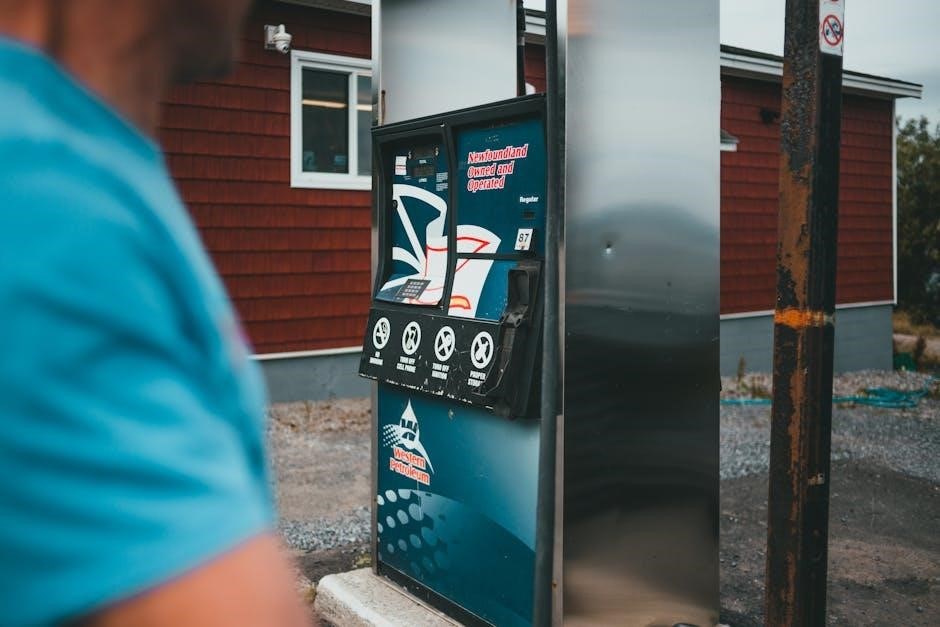dometic rv refrigerator gas and electric manual
The Dometic RV Refrigerator offers reliable cooling solutions for RVs, available in gas and electric models, ensuring efficiency and versatility for outdoor adventures. This manual provides essential guidance for optimal performance and safety.
1.1 Overview of Dometic RV Refrigerator Models

Dometic RV refrigerators are available in various models, catering to different RV sizes and needs. They offer gas, electric, and dual-fuel options, ensuring flexibility for off-grid and on-grid use. Popular models include the CR-50B, CR-60B, and CR-65B, known for their compact design and energy efficiency. These refrigerators feature automatic ignition, adjustable shelves, and crisper drawers for fresh food storage. Designed for durability, they are built to withstand the rigors of RV travel while providing consistent cooling performance. Each model is tailored to meet specific RV lifestyle demands, ensuring reliability and convenience on the go.
1.2 Importance of Understanding the Manual
Understanding the Dometic RV refrigerator manual is crucial for safe and efficient operation. It provides detailed instructions for installation, maintenance, and troubleshooting, ensuring optimal performance. The manual outlines safety precautions, especially for gas and electric modes, to prevent hazards. Familiarizing yourself with the manual helps extend the appliance’s lifespan and prevents costly repairs. It also guides users on energy-saving features and proper food storage techniques. By following the manual, RV owners can enjoy reliable cooling and enhance their overall camping experience with peace of mind.

Key Features of Dometic RV Refrigerator
Dometic RV refrigerators offer dual gas and electric operation, energy efficiency, and advanced safety features. They provide reliable cooling, spacious interiors, and user-friendly controls for optimal performance.
2.1 Gas and Electric Operation Modes
Dometic RV refrigerators feature dual operation modes, allowing users to switch between gas and electric power. Gas mode is ideal for off-grid use, while electric mode is suitable for campsites with power hookups. This flexibility ensures continuous cooling regardless of the RV’s location. The system automatically adjusts to the selected power source, maintaining consistent temperatures. Proper setup and regular maintenance are crucial for optimal performance in both modes, ensuring reliability and efficiency during extended trips.
2.2 Energy Efficiency and Performance
Dometic RV refrigerators are designed for high energy efficiency, minimizing power consumption while maintaining consistent cooling performance. Advanced insulation and smart sensors optimize temperature control, reducing energy use. Gas mode operates efficiently on propane, while electric mode utilizes AC power effectively. These features ensure reliable cooling with minimal resource consumption, making them ideal for extended RV trips. The refrigerators also maintain consistent temperatures, preventing food spoilage and ensuring freshness, even in extreme outdoor conditions.
2.3 Safety Features and Alarms
Dometic RV refrigerators are equipped with advanced safety features to ensure secure operation. Gas models include leak detection and automatic shutdown to prevent hazards. Electric units feature overheat protection and surge protection. Alarms alert users to issues like high temperatures or gas leaks, ensuring prompt action. These safety mechanisms are designed to protect both the appliance and the RV, providing peace of mind during travel. Regular maintenance and adherence to guidelines further enhance safety, making Dometic refrigerators a reliable choice for RV enthusiasts.

Installation and Setup
Proper installation and setup of your Dometic RV refrigerator are crucial for safe and efficient operation. Ensure all connections are secure, especially for gas models, and follow the manual’s guidelines. Leveling the appliance correctly is essential for even cooling. If unsure, consult a professional to avoid potential hazards and ensure optimal performance.
3.1 Pre-Installation Requirements
Before installing your Dometic RV refrigerator, ensure the installation site meets all safety and technical standards. Verify the RV’s electrical and gas systems are compatible with the refrigerator’s specifications. Proper ventilation is essential for gas models to prevent carbon monoxide buildup. Ensure the refrigerator’s dimensions match the designated space, and the RV’s structure can support the appliance’s weight. Check for any obstructions and ensure all necessary connections are accessible. Consulting a professional is recommended to avoid installation errors and ensure compliance with safety guidelines.
3.2 Step-by-Step Installation Guide
Begin by positioning the refrigerator in its designated space, ensuring it is level and secure. Connect the gas line to the appliance, tightening all fittings properly. For electric models, plug the refrigerator into a compatible power source. Install any required ventilation systems for gas models to ensure safe operation. Follow the manufacturer’s instructions for connecting water lines if applicable. Double-check all connections for leaks or loose fittings. Turn on the power or gas supply and test the refrigerator’s operation to ensure it functions correctly. Always adhere to safety guidelines during installation.
3.3 Initial Setup and Configuration
After installation, configure the refrigerator by setting the temperature controls to your desired levels. For gas models, ensure the gas valve is fully open and check for leaks using a soap solution. For electric models, verify the power supply is stable. Activate the refrigerator and allow it to cool for a few hours before adding contents. Program any advanced features, such as automatic mode switching, if available. Test all functions to ensure proper operation and refer to the manual for specific settings. This ensures optimal performance and safety.
Operating the Refrigerator
Operate the Dometic RV Refrigerator by selecting gas or electric mode, adjusting temperature settings, and monitoring performance. Ensure proper ventilation and level placement for efficient cooling and safety.
4.1 Gas Operation Mode
The Dometic RV Refrigerator’s gas operation mode is a popular choice for RVers, offering reliable cooling even without electricity. It runs on propane, making it ideal for off-grid adventures. To use this mode, ensure the propane system is properly connected and the refrigerator is level. Always follow safety guidelines, such as providing adequate ventilation to prevent carbon monoxide buildup. The gas mode is efficient and quiet, ensuring consistent cooling performance. Regular maintenance, like checking the flame and burner, is crucial for optimal function and safety.
4.2 Electric Operation Mode
The electric operation mode of the Dometic RV Refrigerator is ideal for use when a reliable power source is available. It operates quietly and efficiently, eliminating the need for propane. To use this mode, ensure the refrigerator is connected to a 120V AC power supply. The electric mode is energy-efficient and provides consistent cooling performance. It’s perfect for extended stays in campsites with electricity. Always monitor power consumption to avoid overloading circuits. This mode is a convenient alternative to gas, offering seamless operation in powered RV setups.
4.3 Switching Between Gas and Electric Modes
Switching between gas and electric modes on your Dometic RV Refrigerator is straightforward. Always ensure the propane supply is turned off before switching to electric mode. For electric mode, connect to a 120V AC power source. To switch back to gas, allow the system to cool down, then restart in gas mode. This dual functionality ensures flexibility during your RV adventures. Always follow safety guidelines to avoid sudden mode changes, which could affect performance. Proper switching maintains efficiency and extends the appliance’s lifespan.

Maintenance and Care
Regular maintenance ensures optimal performance of your Dometic RV Refrigerator. Clean condenser coils, check door seals, and inspect gas lines for leaks. Schedule annual professional servicing.
5.1 Routine Maintenance Checks
Regular maintenance is crucial for the longevity and efficiency of your Dometic RV Refrigerator. Start by inspecting the door seals for any signs of wear or damage, ensuring a tight seal to maintain internal temperature. Next, clean the condenser coils to prevent dust buildup, which can impede cooling performance. Check the gas lines for leaks and ensure all connections are secure. Additionally, verify that the electric components are functioning properly, including the heating element and thermostat. Finally, drain the evaporator pan to prevent mold growth and odors. By performing these routine checks, you can ensure your refrigerator operates smoothly and efficiently, extending its lifespan and maintaining optimal cooling performance. Always refer to the manual for specific instructions tailored to your model.
5.2 Cleaning and Sanitizing the Refrigerator
Regular cleaning and sanitizing are essential to maintain hygiene and prevent odors in your Dometic RV Refrigerator. Start by turning off the power and removing all contents. Wash shelves and drawers with mild soap and warm water, then rinse thoroughly. Wipe the interior with a solution of equal parts water and white vinegar to sanitize surfaces. Avoid harsh chemicals that may damage components. Dry the interior completely before restoring power. For the exterior, use a gentle cleaner to remove dirt and grime. Regular cleaning ensures optimal performance and keeps your refrigerator fresh and hygienic.
5.3 Replacing Parts and Filters
Regularly replacing parts and filters in your Dometic RV Refrigerator ensures optimal performance and longevity. Check the water and air filters every 3-6 months and replace them as needed to maintain efficiency. Genuine Dometic parts are recommended to guarantee compatibility and safety. When replacing components like seals or heating elements, follow the manual’s instructions to avoid damage. Always turn off power and gas supply before starting any replacement. Proper maintenance prevents breakdowns and ensures your refrigerator operates efficiently, keeping your food fresh and your RV adventures enjoyable.

Troubleshooting Common Issues
Troubleshooting your Dometic RV Refrigerator involves identifying and resolving issues like temperature fluctuations or error codes. Always refer to the manual for specific solutions and guidelines.
6.1 Common Gas-Related Issues
Common gas-related issues with Dometic RV refrigerators include low propane levels, faulty ignition systems, or clogged gas lines. Ensure proper ventilation to avoid carbon monoxide buildup. If the flame fails to light, check the igniter or gas valve. A yellow or orange flame indicates improper combustion, requiring immediate attention. Always turn off the gas supply before troubleshooting. Refer to the manual for specific diagnostic steps and safety precautions to resolve gas-related problems effectively and safely.
6.2 Common Electric-Related Issues
Common electric-related issues with Dometic RV refrigerators include power supply problems, faulty thermostats, or sensor malfunctions. Ensure the electrical connections are secure and the voltage matches the unit’s requirements. If the refrigerator doesn’t cool on electric mode, check for tripped circuit breakers or blown fuses. Faulty heating elements or compressors can also cause issues. Always unplug the unit before performing diagnostics. Consult the manual for troubleshooting steps and reset procedures to restore electric operation efficiently and safely.

6.3 Diagnostic Error Codes and Solutions
Dometic RV refrigerators display error codes to identify issues. Common codes include E1 (temperature sensor fault), E2 (electronic control unit malfunction), and E3 (communication error). To resolve these, check sensor connections, ensure proper power supply, and reset the system. For E1, verify sensor placement and cleanliness. For E2, restart the unit or replace the control board if necessary. E3 may require reconnecting components or updating software. Always consult the manual for specific code meanings and solutions to restore functionality quickly and safely.

Safety Precautions
Ensure safe operation by following all safety guidelines for gas and electric modes. Proper installation, regular inspections, and adherence to manufacturer recommendations are crucial. Always monitor for leaks, maintain ventilation, and keep flammable materials away. Familiarize yourself with emergency shutdown procedures to prevent accidents and ensure reliable performance.
7.1 Gas Safety Guidelines
Always follow gas safety guidelines to ensure safe operation. Ensure proper installation and regular inspections of gas lines and connections. Use a gas leak detector and maintain good ventilation in the RV. Never operate the refrigerator near open flames or sparks. Keep flammable materials away from the appliance. Store propane cylinders upright and securely in a well-ventilated area. Familiarize yourself with emergency shutdown procedures in case of a gas leak or malfunction. Regular maintenance is crucial to prevent hazards and ensure reliable performance.
7.2 Electric Safety Guidelines
Ensure the Dometic RV Refrigerator is installed and operated according to electric safety standards. Use the correct power source and avoid overloaded circuits. Regularly inspect power cords and plugs for damage. Keep the appliance grounded to prevent electric shock. Avoid exposing electrical components to water or moisture. Never operate the refrigerator near open flames or sparks. Ensure proper ventilation to prevent overheating. Always turn off the power before performing maintenance. Follow the manufacturer’s guidelines for electrical connections to ensure safe and reliable operation. Keep children away from electrical components to avoid accidents.
7.3 Emergency Shutdown Procedures
In case of an emergency, immediately turn off the Dometic RV Refrigerator’s power supply. For gas models, close the propane valve and ensure proper ventilation. For electric models, disconnect the power cord from the outlet. If a gas leak is suspected, open windows and avoid sparks. Do not restart the appliance until the issue is resolved. Always follow the manufacturer’s emergency shutdown instructions to ensure safety. Keep emergency contact information handy for professional assistance if needed. Regular maintenance can help prevent emergencies and ensure reliable operation.
Technical Specifications
Dometic RV Refrigerators feature precise dimensions, weight, and power consumption details, ensuring compatibility with various RV systems for seamless integration and reliable performance on the go.
8.1 Dimensions and Weight
Dometic RV Refrigerators come in various sizes to fit different RV layouts. Dimensions typically range from 23 to 60 inches in height and 18 to 24 inches in width. The weight varies depending on the model, with most units weighing between 70 to 150 pounds. These measurements ensure compatibility with standard RV installations. Always refer to the specific model’s manual for exact dimensions and weight to plan installation accurately. Proper sizing is crucial for optimal performance and safe operation.
8.2 Power Consumption and Requirements
Dometic RV Refrigerators are designed to operate efficiently in both gas and electric modes. Electric models typically require a 12V DC or 120V AC power supply, with an average consumption of 100-150 watts. Gas models use propane, with consumption rates varying by model and usage. Always ensure a stable power supply and proper ventilation for gas operation. Refer to the manual for specific power requirements to ensure safe and efficient performance. Proper electrical and gas connections are crucial for reliability and longevity of the appliance.
8.3 Compatibility with RV Systems
Dometic RV Refrigerators are designed to seamlessly integrate with standard RV electrical and gas systems. They are compatible with most RV models, including Class A, B, and C motorhomes, as well as travel trailers. The refrigerators work with 12V DC and 120V AC power systems, ensuring flexibility for different RV setups. Proper installation and ventilation are essential for optimal performance. Always consult the manual for specific compatibility guidelines to ensure safe and efficient operation. Correct installation ensures the appliance functions within the RV’s electrical and gas capacity, preventing potential issues. Regular maintenance also supports long-term compatibility and reliability.
Warranty and Support
Dometic RV Refrigerators come with a comprehensive warranty covering parts and labor for specific periods. Dedicated customer support and authorized service centers ensure prompt assistance and repairs.
9.1 Warranty Coverage and Terms
Dometic RV Refrigerators are backed by a limited warranty covering parts and labor for defects in materials and workmanship. The standard warranty typically lasts for one to two years from the date of purchase, depending on the model and region. Extended warranty options may be available for additional coverage. Proper installation, maintenance, and adherence to usage guidelines are required to maintain warranty validity. Specific terms and conditions vary by product and region, so it’s essential to review the official documentation for detailed information.
9.2 Customer Support and Service Centers
Dometic provides comprehensive customer support through various channels, including phone, email, and online resources. Their network of authorized service centers ensures prompt assistance for repairs, maintenance, and troubleshooting. Customers can access technical support for gas and electric models, helping them resolve issues efficiently. Additionally, Dometic’s website offers downloadable manuals, FAQs, and troubleshooting guides to assist users independently. This extensive support system ensures optimal performance and peace of mind for RV refrigerator owners, addressing their needs effectively and maintaining product reliability.

9.3 Extended Warranty Options
Dometic offers extended warranty options to provide additional protection and peace of mind for RV refrigerator owners. These plans extend beyond the standard warranty period, covering repairs and replacements for parts and labor. Customers can purchase extended warranties through authorized dealers or directly from Dometic. The extended coverage ensures continued reliability and performance of both gas and electric models. It’s recommended to review the terms and conditions before purchasing to understand the scope of coverage and any applicable limitations or exclusions.
Conclusion
Understanding and maintaining your Dometic RV refrigerator ensures reliable cooling and safety. Follow the manual for optimal performance and troubleshoot common issues effectively. Enjoy your adventures with confidence.
10.1 Summary of Key Points
The Dometic RV refrigerator combines gas and electric operation for versatility. Proper installation, regular maintenance, and understanding safety guidelines ensure optimal performance. Troubleshooting common issues and adhering to manual instructions help extend lifespan. Energy efficiency and advanced features make it a reliable choice for RVers. Always follow safety precautions and manufacturer recommendations for gas and electric modes. Regular checks and timely repairs prevent major issues. This guide provides a comprehensive overview to help users maximize their refrigerator’s potential and enjoy consistent cooling during their adventures.
10.2 Final Tips for Optimal Performance
For the best results, ensure your Dometic RV refrigerator is properly leveled and installed. Regularly inspect door seals for tightness and clean condenser coils to maintain efficiency. Monitor temperature settings and adjust as needed for optimal cooling. Avoid overloading the fridge to ensure proper air circulation. Always use the correct gas and electric modes based on your power source. Keep the unit clean and well-ventilated to prevent issues. By following these tips, you’ll enjoy reliable performance, extended lifespan, and consistent cooling during your RV adventures.
Additional Resources
Visit the official Dometic website for detailed manuals and guides.
Explore online forums for user experiences and troubleshooting tips.
Contact authorized service providers for professional assistance and parts.
11.1 Official Dometic RV Refrigerator Manual
The official Dometic RV Refrigerator manual provides a comprehensive guide for gas and electric models, covering installation, operation, and maintenance. It includes detailed instructions for troubleshooting common issues, safety precautions, and technical specifications. The manual also outlines warranty information and offers step-by-step diagrams for repairs. Users can download the manual from Dometic’s official website or request a physical copy from authorized dealers. This resource is essential for ensuring optimal performance and longevity of the refrigerator.
11.2 Online Forums and Communities
Online forums and communities are valuable resources for Dometic RV refrigerator users. Platforms like RV forums, Reddit, and Facebook groups offer peer-to-peer support, troubleshooting tips, and shared experiences. These communities often include discussions on gas and electric models, user manuals, and repair guides. Members can ask questions, share solutions, and learn from others who have hands-on experience. These forums are especially helpful for diagnosing issues and finding creative solutions, making them a great supplement to the official manual.

11.3 Authorized Service Providers
Authorized Dometic service providers are certified experts trained to handle repairs and maintenance for RV refrigerators. They specialize in both gas and electric models, ensuring compliance with safety standards and warranty terms. These providers use genuine Dometic parts, guaranteeing optimal performance and reliability. Users can locate authorized service centers through Dometic’s official website or customer support. Utilizing these services ensures quality repairs and maintains the appliance’s longevity. They are the recommended choice for any issues requiring professional attention, providing peace of mind for RV owners.
